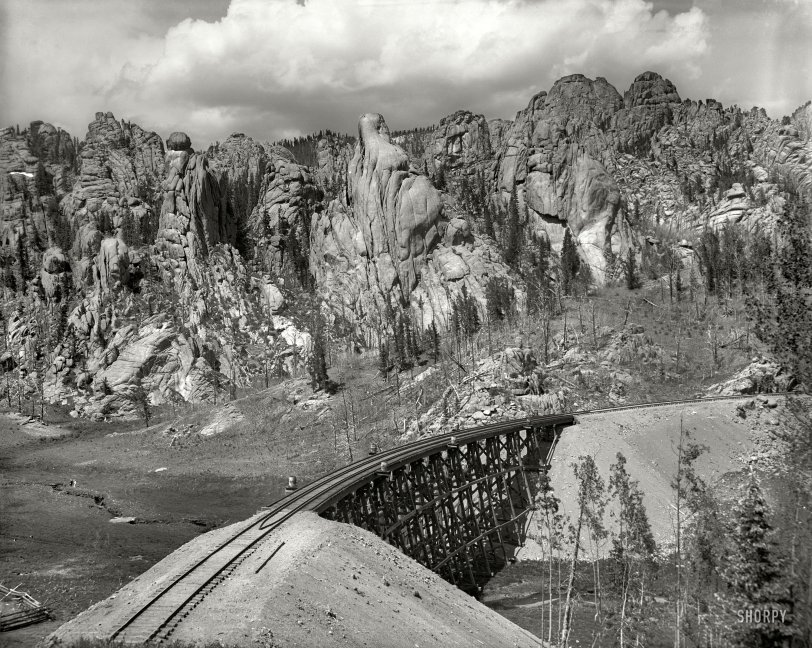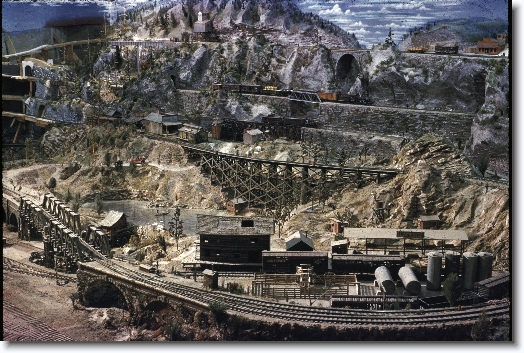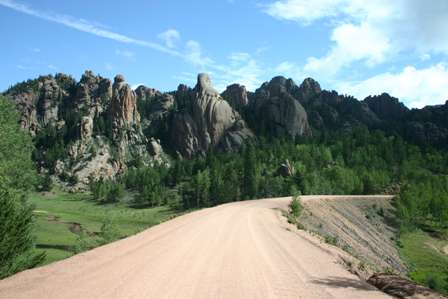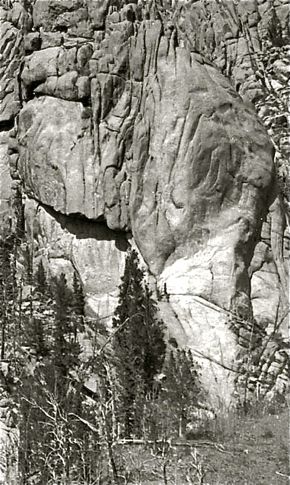


Framed or unframed, desk size to sofa size, printed by us in Arizona and Alabama since 2007. Explore now.
Shorpy is funded by you. Patreon contributors get an ad-free experience.
Learn more.

- Details, Details
- What's that building to the left of the tower?
- Coal Barges
- Bromo-Seltzer
- Inner harbor
- The Basin
- What a headache!
- Giant stepladder?
- Baldwin 62303
- Baldwin VO-1000
- Cold
- No expense spared
- Tough Guys
- Lost in Toyland
- And without gloves
- If I were a blindfolded time traveler
- Smoke Consumer Also Cooks
- Oh that stove!
- Possibly still there?
- What?!?
- $100 Reward
- Freeze Frame
- Texas Flyer wanted
- Just a Year Too Soon
- WWII -- Replacing men with women at the railroad crossing.
- Yes, Icing
- You kids drive me nuts!
- NOT An Easy Job
- I wonder
- Just add window boxes
Print Emporium
Cripple Creek Short Line: 1901

Colorado circa 1901. "Cathedral Park near Clyde. Colorado Springs & Cripple Creek Short Line." A gray day in the Rockies. 8x10 inch glass transparency by William Henry Jackson, Detroit Publishing Company. View full size.
Guard rails on bridges
These were placed between the tracks on bridges in case of a derailment on the bridge. It was hoped that the wheels would be snagged between the outer rail and the guard rail. No doubt the guard rails did not always keep the cars or locomotive from going over the side.
Barrels!
They are there to provide water to fight small fires caused by sparks from the locomotive(s) after they passed by. The bridges were built with either untreated or creosoted timbers, highly susceptible to fire, and the railroads, in those days, hired trackwalkers to keep an eye on bridges like this, as well as many other maintenance issues. A small fire or smolder could easily be put out with a little water from the barrels. Otherwise, the nearest water was in the creek below, IF it wasn't dried up for the summer.
Beautiful area!
I love the area around Cripple Creek and Victor. We go there twice a year. Have never been on Gold Camp Road, but plan to find it and go on it later this year after seeing these pictures.
Bridge Out
In fact, the railroad itself is gone. The road bed is now unpaved Gold Camp Road. The gorge spanned by the railroad bridge has been filled in. This is the area just below Cathedral Park where in 1901 picture was apparently taken. The stream called Bison Creek is still there and flows beneath the filled in section. Following it downhill leads to a small lake it has formed, and signs of life are there.
Twisted by Tempests
The Land of Enchantment: From Pike's Peak to the Pacific.
By Lilian Whiting, 1909.Chapter III
The Picturesque Region of Pike's Peak
…
Every tourist in the Pike's Peak region regards the "Short Line" trip as the very crown of the summer's excursions. These forty-five miles not only condense within their limits the grandeur one might reasonably anticipate during a transcontinental journey of three thousand miles, but as an achievement of mountain engineering, railway experts in both Europe and America have pronounced it the most substantially built and the finest equipped mountain railroad in the world. It was opened in 1901, and, quite irrespective of any interest felt in visiting the gold camps of Cripple Creek, the "Short Line" has become the great excursion which all visitors to Colorado desire to make for the sublime effects of the scenery.
…The "Cathedral Park" is an impressive example of what the forces of nature can accomplish. Colossal rocks, chiselled by erosion, twisted by tempests, worn by the storms of innumerable ages, loom up in all conceivable shapes. They are of the same order as some of the wonderful groups of rocks seen in the Grand Cañon. Towers and arches and temples and shafts have been created by Nature's irresistable forces, and to the strange fantastic form is added color — the same rich and varied hues that render the Grand Cañon so wonderful in its color effects. This "Cathedral Park" is a great pleasure resort for celebrations and picnics, both from Colorado Springs, Colorado City, Broadmoor, and other places from below, and also from Cripple Creek, Victor, and other towns in Cripple Creek District.
…
For the Squirrels.
Concerning the barrels on the trestle.
As mentioned, they are for fire protection, and usually had a hook on the inside upon which was hung a bucket under the water.
The Sectionmen would keep an eye on the barrels and would top them up from time to time from the creek below, sometimes with a bucket on a rope, or, in dry locations or on HIGH bridges, from a special Water Car handled by a Wayfreight or Work Train.
Water could be moved by a hose from a steam locomotive tender.
Squirrels, other animals, and birds would attempt to drink from the barrels, and, if the insides were slick, would fall in, not be able to climb back out, then drown.
A floating piece of wood plank would give them something to climb onto, then jump or fly free.
Sparks could come from locomotive fire boxes and smoke stacks and from red-hot iron brakeshoes on trains descending heavy grades.
Diesel locomotives still set fires with carbon sparks from their exhuasts.
Train and Engine crews were admonished to not throw discarded smoking material from moving trains ( Cigars, Cigarettes, Pipe Dottle, Matches and so forth.)
Written notices would be placed in Cabooses to that effect.
Fusees used for flagging and hand signals would set fires if improperly used.
When cooler weather arrived, the barrels would be emptied, or they would freeze and break, often turned upside-down on the platform, with the bucket underneath.
In spring they would be turned upright, the bucket put back in and filled once again.
Different Companies and climates might dictate different policies, but, thats the way it was done here.
After they became readily available, steel drums and galvanized buckets were used on water barrels on bridges.
Steel drums, with one end removed with a hammer and chisel and with holes put in the sides near the bottom with a pick for draft, still make excellent fire barrels for heat, and burning trash, the latter to discourage bears.
As trash burners, a screen would be used in hot weather to capture sparks.
They glow red at night, the draft holes making spooky patterns on the snow, melting a hole, sparks mixing with the stars as the coyotes serenade the mountains.
Thank You.
The Late Great Gorre & Daphetid
John Allen was my hero when I was a kid building my HO train layout. John was a good photographer himself and his model railroad was the envy of everyone! Sorry end: John died and his friends tried to preserve his masterpiece but the house caught fire. The End. RIP John wherever you are.

Barrels of fun
The barrels that are on the bridge are for fires that might start on the bridge. Because the steam engines would drop hot coals as it went down the tracks, they had these handy barrels that were filled with water and usually painted red. If a track crew or passerby saw any smoke from the bridge after the train past, they could use the water to put the "fire" out.
Magnificent scene
This must rank as the ultimate setting in a model railroader's dream.
Get our your 4WD
Apparently you can drive right up to this point on Gold Camp Road, if you don't mind the rough ride and the sheer drops of the side.
Sand Barrels and Bracing
The extra track over the bridge with the ends meeting appears to be bracing to keep the main track from shifting on the bridge ties. This appears to be an uphill curved grade. Sand from the six barrels could be used for traction without depleting the sand carried by the engine. Not a location for cannon ball runs.
Cinders
It looks like the hill on the far side of the bridge did burn at some point.
Barrels
It is my considered opinion that these barrels on the sides of bridges were there for safety purposes.
Should a railroad worker or other person find himself on the span with a train bearing down on them, they could escape into the nearest barrel.
I'm sure I've seen these barrels on steel bridges; that's why fire fighting seemed unlikely the issue.
Upper Gold Camp Road
I believe this is now the upper Gold Camp Road between Colorado Springs and Cripple Creek. This shows about the same picture. Do a search on Google maps for Gold Camp Road, Colorado and it will take you right to it.

Cliff Faces
I see a Cyclops, Tweedle Dee and Tweedle Dum, monster faces, a Chinese elder and other assorted interesting shapes on this mountain wall.
Curious
What are the barrels on the platforms attached to the bridge for? Gorgeous photograph. The rock formations are fascinating. The couple taking a stroll by the creek help to give perspective to this scene.
Stunning view!
Absolutely beautiful! Looks like it could be the inspiration for the great Gorre & Daphetid RR.
Water Barrels
Beautiful landscape.
Also, those water barrels were there in case the bridge caught fire. Wood burning steam engines were prone to throw cinders out the stack. They would frequently start brush fires or even set the wood-roofed train cars on fire.
Jumbotron
The part of the picture, shown below, sort of looks like the Elephant is leaving the room.

Missed the Train
Did those two dressed-up people miss the last train?
Barrels?
What's the purpose of the barrels placed on the bridge? The only thing I can come up with is some kind of primitive vibration damping system.
Barrels?
Anyone know the purpose of the barrels on the side of the bridge?
Rock formations win the scene
Not so much the railroad theme but check out the interesting rock formations.
























On Shorpy:
Today’s Top 5